Insert
a Geometrical Set
You can add a geometrical set in the specification tree.
In the specification tree, select an element as the
location of the new geometrical set.
This element will be considered as a child of
the new geometrical set and can be a geometrical set or a feature.
Select Insert > Geometrical Set...
from the menu bar.
The Features list displays
the elements to be contained in the new geometrical set.
Enter the name of
the new geometrical set.
Use the Father drop-down
list to choose the body where the new geometrical set is to be inserted.
All destinations present in the document are listed allowing you to
select one to be the father without scanning the specification tree.
They can be:
-
geometrical sets
-
3D shape representations
-
bodies
Select additional entities that are to
be included in the new geometrical set.
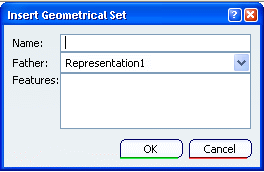
Click OK to create the geometrical
set at the desired location.
The result is immediate. CATIA displays this new Geometrical
Set.x, incrementing its name in relation to the pre-existing
bodies, in the specification tree. It is created after the last
current geometrical set and is underlined, indicating that it
is the active geometrical set. The next created element is created
within this geometrical set.

Remove
a Geometrical
Set
You can remove ta geometrical set from specification tree.
- Two methods are available:
- If you want to delete the geometrical set and all its contents:
Right-click the geometrical set then select the
Delete contextual command.
- If you want to delete the geometrical set but keep its contents.
This is only possible when the father location of the geometrical
set is another geometrical set. This is not possible when the father
location is a root geometrical set.
Right-click the desired geometrical set then select
the Geometrical Set.x object > Remove Geometrical Set
contextual command.
The geometrical set is removed and its constituent entities
are included in the father geometrical set.

Move
a Geometrical Set to a New Body
You can move a whole branch, i.e. a whole body and its contents,
at a time.
From the specification tree, select the geometrical
set then choose the Geometrical Set.object > Change Geometrical
Set... item from the contextual menu.
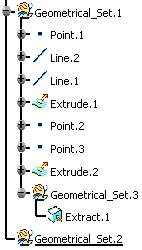
The Change geometrical set
dialog box is displayed, listing all the possible destinations.
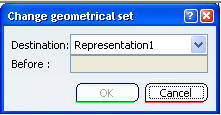
Select the Destination body where the
geometrical set is to be located.
You can do so by selecting the body in the specification
tree, or using the drop-down list from the dialog box.
By default, if you select a body, the geometrical set is
positioned last within
the new body. However, you can select any element in the
new body, before which the moved geometrical set will be
located.
Click OK to move the geometrical set
to the new body.
The geometrical set is moved to its new location in
the specification tree, but geometry remains unchanged.
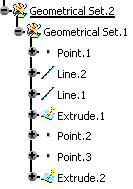

Move
Elements of a Geometrical Set to a
New Body
You can move elements of a geometrical set to a new body.
From the specification tree, select the element(s)
then choose the Extrude.2 object > Change Geometrical Set...
item from the contextual menu.
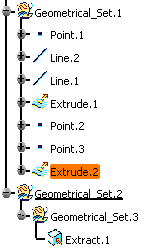
The Change geometrical set
dialog box is displayed, listing all the possible destinations.
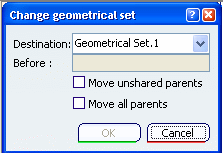
Select the Destination body where the
geometrical set is to be located.
You can do so by selecting the body in the specification
tree, or using the drop-down list from the dialog box.
By default, if you select a body, the geometrical
set is positioned last
within the new body. However, you can select any element
in the new body, before which the moved elements will be
located.
Select the element above which the one you already
selected is to be inserted.
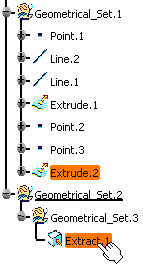
You can directly select this positioning element. In
this case the Destination box is automatically
updated with the body to which this second element belongs.
Click OK to move the elements to the
new body.
The element selected first is moved to its new location
in the specification tree, but geometry remains unchanged.
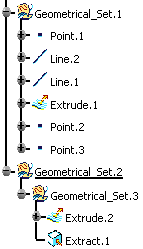
- Select the Move unshared parents check
box to move all parents of the first selected element
to its new location, provided these parents are not
shared by any other element of the initial body.
In this case, all the unshared parents are highlighted
prior to the move.
- Select the Move all parents check box
to move all parents of the first selected element to
its new location, regardless of whether these parents
are used (shared) by any other element of the initial
body.
In this case, all the parent elements are highlighted
prior to the move.
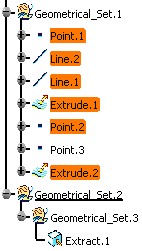

Sort
the Contents of a
Geometrical Set
You may need to sort the contents of a geometrical set, when the
geometric elements no longer appear in the logical creation order. In
that case, use the Auto-sort capability to reorder the geometrical set
contents in the specification tree (geometry itself is not affected).
In our example, Geometrical Set.1 contains two extruded surfaces
based on point-point lines. The specification tree looks like this:
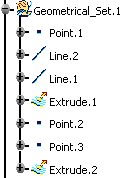
- Right-click Geometrical Set.1 from the specification
and choose the Geometrical Set.1 object > AutoSort
command.
Instantly, the contents of the Geometrical Set are reorganized
to show the logical creation process.
The geometry remains unchanged.
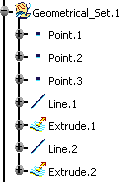

Reorder
Elements within a Geometrical
Set
You can reorder elements inside the same geometrical
set.
Right-click the geometrical set from the specification
tree and choose the Geometrical Set.x object > Reorder Children
command.
The Reorder Children dialog box is displayed.
Select an element.
Use the arrows to move an element up or down.
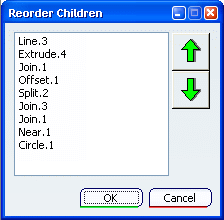

Drag and Drop Elements
You can drag one element (feature or parent's node)
from one location, drop it to another location and keep its original name
and location.
- For instance, drag Geometrical Set.1 and drop in Geometrical
Set.2.
Before
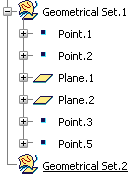
After
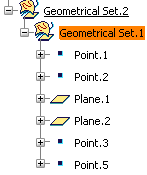

Replace Elements
You can replace the elements in the geometrical set.
This capability is only available on shape elements.
Right-click the geometrical set from the specification
tree and choose the Geometrical Set.x object > Replace...
command. The Replace dialog box is displayed.
Select the replacing element. Click OK.
For more information, refer to the Replacing Elements chapter in the
Part Design User's Guide. To manage this capability, the Do replace only for elements
situated after the In Work Object option is available in Tools > Options > Infrastructure > 3D Shape Infrastructure > General
tab. It allows you to make the Replace option possible only for
features located below the feature in Work Object and in the same branch.
|
![]()
![]()
![]()
![]()


![]()
![]()
 After
After









